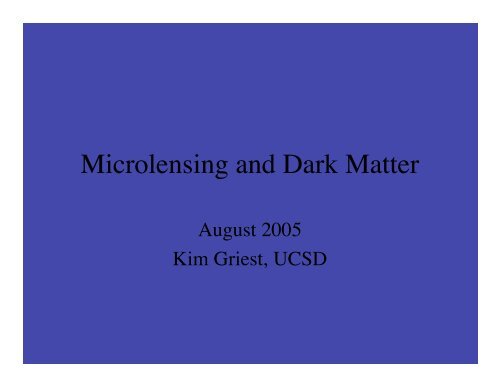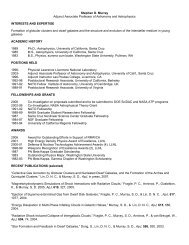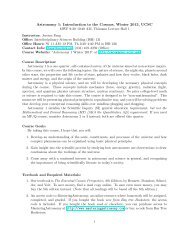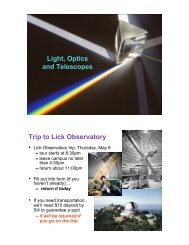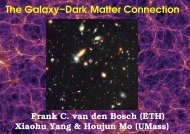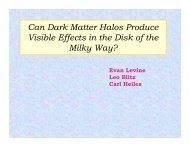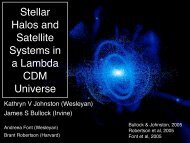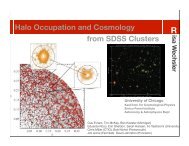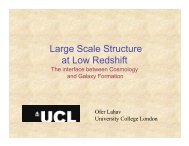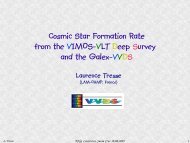Kim Griest
Kim Griest
Kim Griest
Create successful ePaper yourself
Turn your PDF publications into a flip-book with our unique Google optimized e-Paper software.
Microlensing and Dark Matter<br />
August 2005<br />
<strong>Kim</strong> <strong>Griest</strong>, UCSD
•Surveys monitor millions of<br />
stars for years to find<br />
rare lensing events<br />
• Bulge => stars, remnants,<br />
planets, etc.<br />
•LMC/SMC/M31 => DM
Executive Summary<br />
• Basic Result: Searches done and show bulk<br />
of DM cannot be in compact objects with<br />
masses between Mars mass and 100 Msun<br />
• Conflicting results on whether ANY halo<br />
DM can exist in this form: 2 collaborations<br />
say yes, 2 say no<br />
• IF measurable amount of Macho halo DM<br />
exists, it would be a major new component<br />
of MW (and M31) => important<br />
consequences for galaxy formation and<br />
evolution
MACHO Collaboration (2000)<br />
• Monitored 11.9 million stars for 5.7 years<br />
• Found 13-17 events (depending on selection criteria)<br />
• Careful efficiency analysis including blending<br />
• Removed 8 Supernova behind LMC (contaminants)<br />
• Distribution in space, CMD, Amax, consistent with<br />
microlensing interpretation<br />
• Likelihood analysis to measure Macho DM, plus<br />
events in disk, LMC, etc.
LMC in<br />
neutral H<br />
looks like<br />
a face-on<br />
disk.
Test of<br />
systematic<br />
error due to<br />
contamination,<br />
selection bias:<br />
compare A<br />
B criteria<br />
Criteria A:<br />
tighter cuts,<br />
with less<br />
contamination<br />
Criteria B:<br />
looser cuts,<br />
with more<br />
contamination
•Masses 0.1 -<br />
1.0 Msun<br />
preferred<br />
•Halo fraction 8%<br />
- 40% preferred<br />
•Total mass in<br />
Machos: 8-10<br />
10^10 Msun<br />
(MW disk=6<br />
10^10 Msun, and<br />
MW halo has 4-6<br />
10^11 Msun)<br />
•Optical depth =<br />
1.2+0.4-0.3 10^-7
• Main conclusion: Macho’s as main<br />
component of Dark Matter are ruled out<br />
• But found significant extra microlensing
The number of non-Macho events is predicted to be much<br />
smaller than the 13-17 events observed (using standard LMC<br />
and Milky Way stellar populations.)
But these results need correcting<br />
• Recently EROS (Glicenstein 2004) found that<br />
event LMC-23 bumped again after 7 years =><br />
variable star, not lensing.<br />
• LMC-23 contributed 8% of optical depth (and<br />
halo fraction) (6% for set B), so all our optical<br />
depths and halo fractions should be reduced at<br />
least 8%.<br />
• => best f = 18.5%, and tau=1.1 10^-7 (<strong>Griest</strong> &<br />
Thomas), or f=16%, tau=1 10^-7 (Bennett)<br />
• More worrying: are there more events like this?
LMC-23
What does extra LMC<br />
microlensing mean?<br />
1. If events are in MW halo =><br />
- significant portion of DM<br />
- problem exists: What are they?<br />
-- stellar mass but can’t be stars (stars shine!)<br />
-- stellar remnant (white dwarfs, black holes) would need<br />
lots of early stars: no evidence for these (metal<br />
enrichment, background light, etc.) WD observed?<br />
-- primordial black holes? quark nuggets?<br />
2. If events are LMC self lensing =><br />
- current LMC models wrong?<br />
- lens stars should be seen?<br />
3. Contamination in MACHO dataset?
Much written on LMC self lensing since Sahu/Wu/Gould 1994<br />
•MACHO used Gyuk, Dalal, <strong>Griest</strong> review of LMC models, valid in<br />
2000, to predict 1-2 LMC self-lensing microlensing events. At that<br />
time no evidence of other stellar populations to do the self lensing.<br />
•HOW ABOUT RECENT EVIDENCE?<br />
•Zhao, Ibata, Lewis, & Irwin(2003) did 1300 2dF radial velocities:<br />
no evidence for any extra population over expected LMC and<br />
Galaxy<br />
Any new kinematically distinct population less than 1%.<br />
(rules out Evans & Kerrins 2000 fluffy stellar halo model)
• Gallart, Stetson, Hardy, Pont, & Zinn (2004), search for a stellar<br />
population in a deep surface brightness CMD, and found no<br />
evidence for any stellar halo<br />
• However, Minniti, et al (2003), and Alves (2004) found RVs for 43<br />
RR Lyaes and discovered an old and hot stellar halo! But they say<br />
it is too small to account for all the extra microlensing<br />
• But the structure of the LMC is being questioned: van der Marel,et<br />
al (2002) says the LMC disk is not circular, but Nikolaev, et al.<br />
(2004) disagree, saying it is warped. Both say it does not probably<br />
affect self lensing much (e.g. Mancinit etal 2003 agree), but it does<br />
show the LMC is still not well understood.<br />
• Summary: no clear answer yet
Contamination?<br />
• Contamination was studied by MACHO; selection<br />
criteria:<br />
A: 13 events, tight cuts, less contamination., lower effs<br />
B: 17 events, loose cuts, more contam., higher effs<br />
tau(A) =1.1e-7, tau(B)=1.3e-7.<br />
17% difference estimates contamination systematics<br />
• But Belokurov, Evans, & LeDu used neural net to<br />
reanalyze MACHO LMC data. Say data set is badly<br />
contaminated; find only 6 or 7 microlensing events =><br />
tau much smaller => no need for either Machos in dark<br />
halo or extra LMC self lensing!
Wrong!<br />
• Found events by running only on our selected events, but<br />
calculated efficiencies without including effect of our<br />
selection => badly miscalculated efficiencies.<br />
• Analyzed only 22000 lightcurves out of 11.9 million<br />
• Also used very weak statistics => much lower eff, and<br />
many false positives (2 out of 22000) => probably would<br />
not even work if applied to all 11.9 million lightcurves<br />
• Rejected good microlensing, misidentified SN<br />
Conclusion: BEL analysis is meaningless; neural nets<br />
may be useful, but have yet to be applied correctly.<br />
Contamination possible, but certainly not shown yet.<br />
Results of MACHO LMC5.7 stand after small correction<br />
for LMC-23.
What do to?<br />
Other experiments!
EROS collaboration: 4 events in 50 LMC fields and 4 events in<br />
10 SMC fields: Interpreted as limit on Halo dark matter<br />
LMC<br />
Events
Combined MACHO and EROS limits on short duration = small<br />
mass objects
Limits vary<br />
according to<br />
Milky Way halo<br />
model
LMC Limits on Macho Dark<br />
Matter<br />
• MACHO plus published EROS: Objects with 10 -7<br />
< m < 10 -3 Msun make up less than 25% of DM.<br />
Objects with 3.5 10 -7 < m < 4.5 10 -5 make up less<br />
than 10% of DM<br />
• EROS conference proceedings: (3 events from 33<br />
million stars over 100 sq deg)<br />
Objects with 10 -4 < m < 10 0 Msun make up less<br />
than 12% of DM (best fit Macho halo fraction of<br />
3%). (astro-ph/0501584) (CONFLICTS WITH<br />
MACHO RESULT)
• M31 microlensing is the new frontier<br />
(and site of new controversies!)<br />
• At least 4 groups have returned results<br />
(but situation not clarified!)<br />
• Key idea was to use M31 inclination and<br />
near/far asymmetry: if Macho halo, many<br />
more events should appear on far side of<br />
M31
MEGA:<br />
M31 Microlensing<br />
Found 4 events:<br />
Measure Macho<br />
halo fraction<br />
f=0.29 +0.30 -0.13<br />
.01< m < 1 Msun<br />
=> M31 halo<br />
DM consistent<br />
With LMC result!<br />
BUT POINT-<br />
AGAPE M31<br />
3 events says<br />
f
More recently: reversal!<br />
• POINT/AGAPE has 6 events; model M31; say more<br />
than self-lensing: halo fraction: f >20% for .5
Other M31 results<br />
• WeCAPP (Wendelstein Calar Alto<br />
Pixellensing project) found 2 events toward<br />
M31. Say favor M31 halo lenses, but<br />
evidence very weak (in my opinion).<br />
• Nainital group found one M31 event (on far<br />
side), no conclusions.
What does it mean?<br />
• Experimentally not clear: need more M31 work<br />
(MEGA/POINT-AGAPE, etc); Supermacho on LMC.<br />
From space can do parallax and (if approved) can answer<br />
question of where lenses are; eventually SIM and do<br />
astrometric microlensing. (Measure distance to 2 or 3<br />
LMC lenses as 10 kpc to prove Macho DM. 3 or 4 at 50<br />
kpc proves LMC self-lensing.) Need better modeling of<br />
M31.<br />
• Exciting current event: Spitzer IR satellite project<br />
approved to get parallax (Gould et al). Currently following<br />
an SMC event. Very likely to get distance.<br />
• Theoretically: Macho DM consistent with<br />
Omega_baryon = 0.04, but causes problems with star and<br />
galaxy formation, or requires very exotic objects.
BULGE<br />
Microlensing:<br />
three<br />
collaborations<br />
returned<br />
results:<br />
OGLE, EROS, MACHO<br />
Results now very consistent<br />
With modern models of the<br />
Milky Way (e.g. Bissant &<br />
Gerhard; Han & Gould)
Microlensing towards bulge<br />
• 50 million stars over 7 years<br />
• >450 events, 60 on clump giants (less blended)<br />
• ~40 binary events, parallax, extended source,<br />
lensing of variable stars, etc.<br />
• Optical depth = 2.18 +.45-.38 10 -6 , agrees with<br />
models (e.g. Gould and Han 1.63 10 -6 )<br />
• Also found optical depth as a function of (b,l)<br />
and gradient in optical depth
34 candidate<br />
events probably<br />
from the<br />
recently<br />
discovered<br />
Sagitarious<br />
dwarf galaxy
The first planet to be discovered by microlensing: OGLE 2003-BLG-233/<br />
MOA 2003-BLG-53; q=.0039. Likely star mass of 0.4 Msun, likely<br />
Planet mass of 1.5 M_jupiter.<br />
Second planet found in June (OGLE-2005-BLG-071).<br />
0.05 < m/M_jupiter < 4, at distance of several kpc; very high S/N
Conclusion<br />
• The mystery of LMC/M31 microlensing is still unsolved,<br />
and more work is needed<br />
• If you want an inventory of all compact objects,<br />
independent of luminosity microlensing is the way to go,<br />
i.e. Microlensing has a bright future for finding dark<br />
objects


